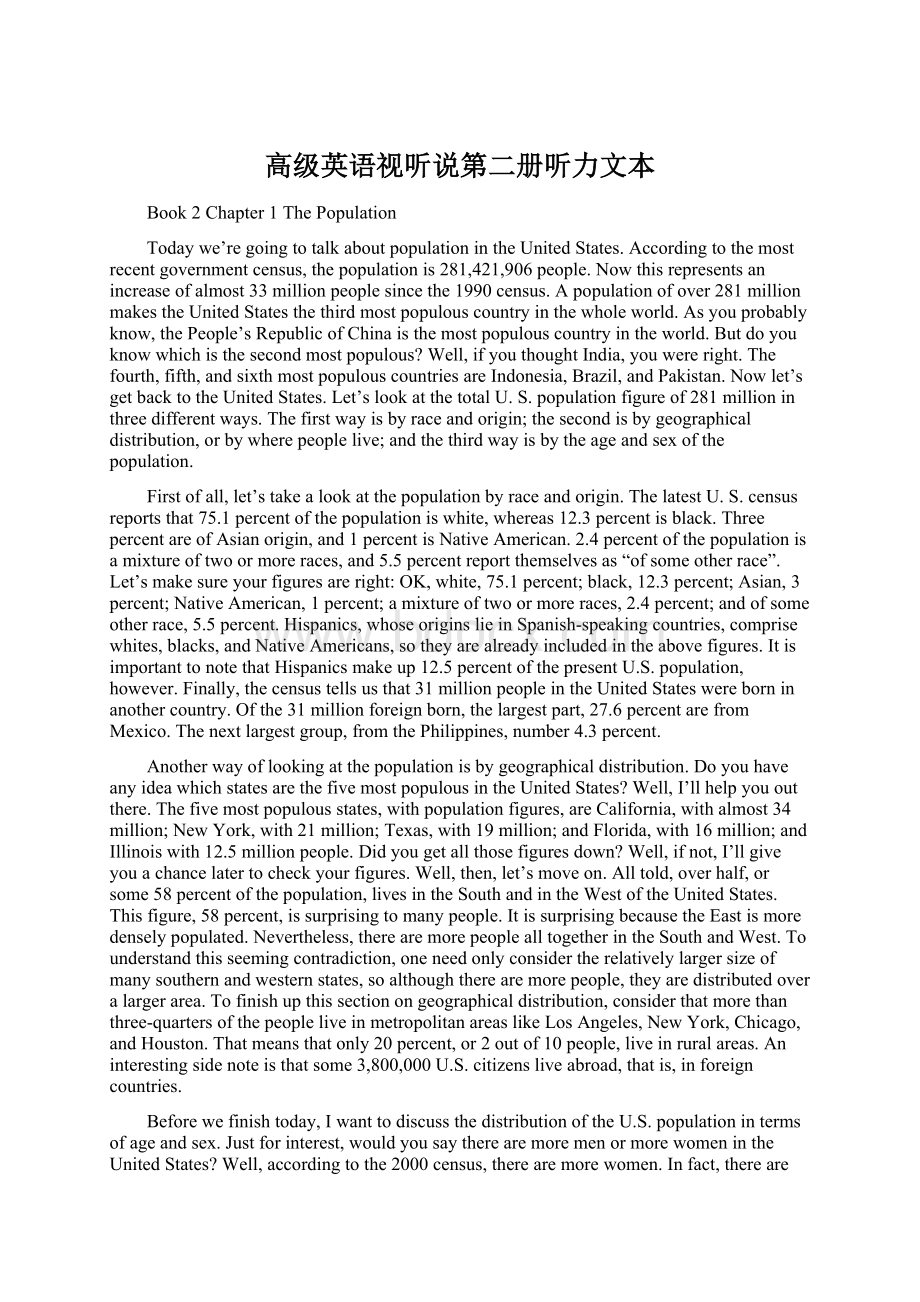高级英语视听说第二册听力文本.docx
《高级英语视听说第二册听力文本.docx》由会员分享,可在线阅读,更多相关《高级英语视听说第二册听力文本.docx(27页珍藏版)》请在冰豆网上搜索。

高级英语视听说第二册听力文本
Book2Chapter1ThePopulation
Todaywe’regoingtotalkaboutpopulationintheUnitedStates.Accordingtothemostrecentgovernmentcensus,thepopulationis281,421,906people.Nowthisrepresentsanincreaseofalmost33millionpeoplesincethe1990census.Apopulationofover281millionmakestheUnitedStatesthethirdmostpopulouscountryinthewholeworld.Asyouprobablyknow,thePeople’sRepublicofChinaisthemostpopulouscountryintheworld.Butdoyouknowwhichisthesecondmostpopulous?
Well,ifyouthoughtIndia,youwereright.Thefourth,fifth,andsixthmostpopulouscountriesareIndonesia,Brazil,andPakistan.Nowlet’sgetbacktotheUnitedStates.Let’slookatthetotalU.S.populationfigureof281millioninthreedifferentways.Thefirstwayisbyraceandorigin;thesecondisbygeographicaldistribution,orbywherepeoplelive;andthethirdwayisbytheageandsexofthepopulation.
Firstofall,let’stakealookatthepopulationbyraceandorigin.ThelatestU.S.censusreportsthat75.1percentofthepopulationiswhite,whereas12.3percentisblack.ThreepercentareofAsianorigin,and1percentisNativeAmerican.2.4percentofthepopulationisamixtureoftwoormoreraces,and5.5percentreportthemselvesas“ofsomeotherrace”.Let’smakesureyourfiguresareright:
OK,white,75.1percent;black,12.3percent;Asian,3percent;NativeAmerican,1percent;amixtureoftwoormoreraces,2.4percent;andofsomeotherrace,5.5percent.Hispanics,whoseoriginslieinSpanish-speakingcountries,comprisewhites,blacks,andNativeAmericans,sotheyarealreadyincludedintheabovefigures.ItisimportanttonotethatHispanicsmakeup12.5percentofthepresentU.S.population,however.Finally,thecensustellsusthat31millionpeopleintheUnitedStateswereborninanothercountry.Ofthe31millionforeignborn,thelargestpart,27.6percentarefromMexico.Thenextlargestgroup,fromthePhilippines,number4.3percent.
Anotherwayoflookingatthepopulationisbygeographicaldistribution.DoyouhaveanyideawhichstatesarethefivemostpopulousintheUnitedStates?
Well,I’llhelpyououtthere.Thefivemostpopulousstates,withpopulationfigures,areCalifornia,withalmost34million;NewYork,with21million;Texas,with19million;andFlorida,with16million;andIllinoiswith12.5millionpeople.Didyougetallthosefiguresdown?
Well,ifnot,I’llgiveyouachancelatertocheckyourfigures.Well,then,let’smoveon.Alltold,overhalf,orsome58percentofthepopulation,livesintheSouthandintheWestoftheUnitedStates.Thisfigure,58percent,issurprisingtomanypeople.ItissurprisingbecausetheEastismoredenselypopulated.Nevertheless,therearemorepeoplealltogetherintheSouthandWest.Tounderstandthisseemingcontradiction,oneneedonlyconsidertherelativelylargersizeofmanysouthernandwesternstates,soalthoughtherearemorepeople,theyaredistributedoveralargerarea.Tofinishupthissectionongeographicaldistribution,considerthatmorethanthree-quartersofthepeopleliveinmetropolitanareaslikeLosAngeles,NewYork,Chicago,andHouston.Thatmeansthatonly20percent,or2outof10people,liveinruralareas.Aninterestingsidenoteisthatsome3,800,000U.S.citizensliveabroad,thatis,inforeigncountries.
Beforewefinishtoday,IwanttodiscussthedistributionoftheU.S.populationintermsofageandsex.Justforinterest,wouldyousaytherearemoremenormorewomenintheUnitedStates?
Well,accordingtothe2000census,therearemorewomen.Infact,therearemorethanfivemillionmorewomenthanmenintheU.S.population.Ifweconsiderthatmoremalesthanfemalesareborneachyear,howcanthisdifferencebeexplained?
Well,foravarietyofcomplicatedreasonsthatwecan’tgointohere,thereisaprogressivelyhigherdeathrateformalesastheygetolder.Thisisseenin2003lifeexpectancyfigures:
thelifeexpectancyforwomenis80.4yearswhereasformenitisonly74.5years.Idon’tknowhowtheselifeexpectancyfigurescomparetothoseinyourcountries,butstatisticallywomengenerallylivelongerthanmenworldwide.Now,tofinishup,let’slookattheaverageageofthewholepopulation.Overall,theaverageageofthepopulationisincreasing:
from33.1yearsin1990to35.3yearsin2000.Theaverageagehasbeenslowly,butsteadily,increasingoverthepastseveraldecades.Thistrendtowardahigheraverageagecanbeexplainedbyadecreasingbirthrateandanincreasinglifeexpectancyforthepopulationasawhole.Well,I’dliketoinvestigatethesetwosubjectsfurther,butIseeourtimeisup,sowe’llhavetocallitquitsfortoday.YoumaywanttopursuethetopicoftheagingU.S.populationfurther,sotherearesomesuggestionsattheendofthelessontohelpyoudoso.Thankyou.
ChapterTwoImmigration:
PastandPresent
Theactofimmigrating,orcomingtoanewcountrytolive,iscertainlynothingnew.Throughouthistory,peoplehaveimmigrated,ormovedtonewcountries,formanydifferentreasons.Sometimesthesereasonswereeconomicorpolitical.Otherpeoplemovedbecauseofnaturaldisasterssuchasdroughtsorfamines.Andsomepeoplemovedtoescapereligiousorpoliticalpersecution.Nomatterwhatthereason,mostpeopledonotwanttoleavetheirnativelandanddosoonlyundergreatpressureofsomesort,butafewpeopleseemquiteadventuresomeandrestlessbynatureandliketomovealot.ItseemsbothkindsofpeoplecametoAmericatolive.ThesubjectofimmigrationisquitefascinatingtomostAmericans,astheyviewthemselvesasanationofimmigrants.However,theearlyBritonswhocametowhatistodaytheUnitedStatesconsideredthemselves“settlers”or“colonists,”ratherthanimmigrants.Thesepeopledidnotexactlythinktheyweremovingtoanewcountrybutweremerelysettlingnewlandforthe“mothercountry.”TherewerealsolargenumbersofDutch,French,German,andScotch-Irishsettlers,aswellaslargenumbersofblacksbroughtfromAfricaasslaves.AtthetimeofindependencefromBritainin1776,about40percentofpeoplelivinginwhatisnowtheUnitedStateswerenon-British.Themajorityofpeople,however,spokeEnglish,andthetraditionsthatformedthebasisoflifeweremainlyBritishtraditions.ThisperiodwehavejustbeendiscussingisusuallyreferredtoastheColonialPeriod.Today,we’realittlemoreinterestedinactualimmigrationafterthisperiod.Let’sfirstlookatwhatisoftencalledtheGreatImmigration,whichbeganabout1830andendedin1930.Thenlet’sconsiderthereasonsforthisso-calledGreatImmigrationandthereasonsitended.Finally,let’stalkabouttheimmigrationsituationintheUnitedStatestoday,
AsIsaid,we’llbeginourdiscussiontodaywiththeperiodofhistorycalledtheGreatImmigration,whichlastedfromapproximately1830to1930.ItwillbeeasierifwelookattheGreatImmigrationintermsofthreemajorstages,ortimeperiods.Thefirststagewasfromapproximate1y1830to1860.Now,beforethistime,thenumberofimmigrantscomingtotheUnitedStateswascomparativelysmall,onlyabout10,000ayear.However,theratebegantoclimbinthe1830swhenabout600,000immigrantsarrived.Theratecontinuedtoclimbduringthe1840swithatota1of1,700,000peoplearrivinginthatdecade.Theratecontinuedtoclimb,andduringthe1850s2,600,000immigrantsarrived.DuringthisfirststageoftheGreatImmigration,thatis,betweentheyears1830and1860,themajorityofimmigrantscamefromGermany,GreatBritain,andIreland.Nowlet’sconsiderthesecondstageoftheGreatImmigration.Thesecondstagewasfroml860to1890,duringwhichtimeanother10,000,000peoplearrived.Betweenl860and1890themajorityofimmigrantscontinuedtobefromGermany,Ireland,andGreatBritain.However,duringthesecondstage,asmallerbutsignificantnumberofimmigrantscamefromtheScandinaviannationsofDenmark,NorwayandSweden.ThethirdstageoftheGreatImmigration,whichlastedfrom1890to1930,wastheeraofheaviestimmigration.Betweentheyearsl890andl930,almost22millionimmigrantsarrivedintheUnitedStates.MostofthesenewarrivalscamefromtheSouthernEuropeancountriesofGreece,Italy,Portugal,andSpainandtheEasternEuropeancountriesofPolandandRussia.
NowthatweknowsomethingaboutthenumbersandoriginsofimmigrantswhocametotheStatesduringtheGreatImmigration,let’sconsiderthereasonswhymostofthesepeopleimmigratedtotheUnitedStates.WhydidsuchlargenumbersofEuropeansleavetheirhomesforlifeinanunknowncountry?
Itwouldbeimpossibletodiscussallthecomplexpoliticalandeconomicreasonsinanydepthtoday,butwecantouchonafewinterestingfactsthatmighthelptoclarifythesituationforyou.Firstofall,oneofthemostimportantreasonswasthatthepopulationofEuropedoubledbetweentheyears1750and1850.Atthesametimethatthepopulationwasgrowingsorapidly,theIndustrialRevolutioninEuropewascausingwidespreadunemployment.ThecombinationofincreasedpopulationandthedemandforlandbyindustryalsomeantthatfarmlandwasbecomingincreasinglyscarceinEurope.ThescarcityoffarmlandinEuropemeantthattheabundanceofavailablelandinthegrowingcountryoftheUnitedStateswasagreatattraction.Duringtheseyears,theUnitedStateswasanexpandingcountryanditseemedthattherewasnoendtoland.Infact,in1862,thegovernmentofferedpubliclandfreetocitizensandtoimmigrantswhowereplanningtobecomecitizens.Inadditiontoavailablefarmland,therewerealsoplentifuljobsduringtheseyearsofgreateco